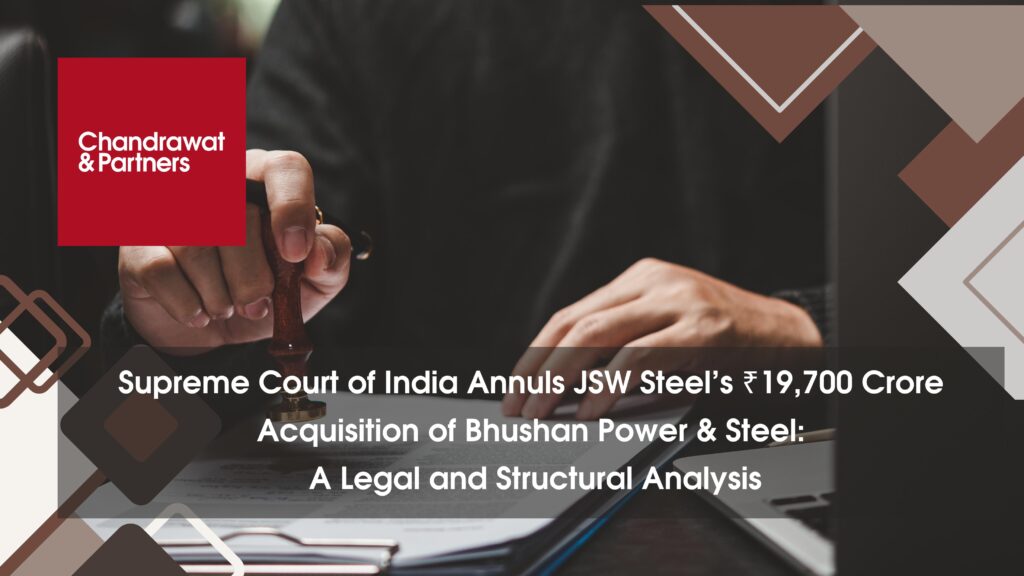Home > Recent Judgements > Supreme Court of India Annuls JSW Steel’s ₹19,700 Crore Acquisition of Bhushan Power & Steel: A Legal and Structural Analysis
May 03, 2025
Supreme Court of India Annuls JSW Steel’s ₹19,700 Crore Acquisition of Bhushan Power & Steel: A Legal and Structural Analysis
On May 2, 2025, the Supreme Court of India issued a landmark judgment that shook the foundations of the country’s insolvency resolution framework. The apex court annulled JSW Steel’s ₹19,700 crore acquisition of Bhushan Power & Steel Ltd. (BPSL), branding the resolution plan as “illegal.” This judgment is not merely a commercial setback for JSW Steel – it redefines how insolvency proceedings must adhere to legal and procedural sanctity under the Insolvency and Bankruptcy Code (IBC), 2016.
Case Background: A Major Acquisition Meets Legal Headwinds
Bhushan Power & Steel, one of India’s largest steelmakers, became insolvent in 2017 with debts exceeding ₹47,000 crore. After a protracted bidding process, JSW Steel was approved as the successful resolution applicant by the Committee of Creditors (CoC) in 2019, offering ₹19,700 crore.
Though NCLT and NCLAT approved the plan, concerns surfaced over:
- Alleged fraudulent transactions by BPSL’s previous management.
- The Enforcement Directorate’s (ED) seizure of assets worth ₹4,025 crore under the Prevention of Money Laundering Act 2002 (PMLA).
- Delays and irregularities in resolution proceedings.
In December 2024, the Supreme Court ordered the ED to return seized assets to JSW Steel, reinforcing the IBC’s primacy. However, what followed in May 2025 turned the tide dramatically.
Supreme Court Ruling: Key Findings and Observations
The Supreme Court’s 2025 judgment goes beyond the specific transaction and critiques systemic failures within the insolvency ecosystem:
- Non-Compliance with the IBC Process
The Court found fundamental violations of the IBC’s guiding principles:
- Lack of transparency in the evaluation and approval of the resolution plan.
- Inadequate disclosures by the resolution professional.
- Procedural shortcuts that compromised the rights of stakeholders.
- Negligence by the Resolution Professional and CoC
The Court strongly rebuked both:
- The Resolution Professional for failing to properly scrutinize the resolution applicant and relevant transactions.
- The CoC for giving preference to recovery maximization over procedural integrity and equitable treatment of all creditors.
- Violation of Section 30(2) and 31(1) of the IBC
The resolution plan failed to meet critical legal thresholds:
- Fair and equitable treatment of operational creditors.
- Legal compliance in submission and approval stages.
- Impact on Stakeholders Overlooked
The Court emphasized that resolution plans must consider:
- Interests of smaller operational creditors.
- Workers, employees, and minority stakeholders – often ignore high-value takeovers.
Deeper Implications of the Judgment
- IBC Integrity Reasserted
The ruling sends a clear message that commercial expediency cannot trump legal compliance. The IBC is not just a debt recovery mechanism—it’s a legal framework with due process at its core.
- Heightened Scrutiny of Resolution Professionals
This judgment places greater accountability on resolution professionals, who serve as quasi-officers of the Court. Their due diligence responsibilities will now likely face tighter regulatory oversight.
- Investor Caution in Stressed Asset Bids
This decision may chill aggressive bids for insolvent companies. Potential investors will now more carefully assess legal risks, procedural compliance, and historical liabilities, not just asset value.
- Strengthened Role of Judiciary in Insolvency
The Supreme Court is increasingly positioning itself as the constitutional guardian of fairness in insolvency. This expands its oversight role vis-à-vis quasi-judicial bodies like NCLT/NCLAT.
Outcome: Liquidation and Future of BPSL
The Court ordered Bhushan Power & Steel Ltd. into liquidation – an outcome that reverses years of resolution effort. This:
- Raises serious concerns about the efficiency of India’s insolvency regime.
- Highlights the need to refine checks and balances for CoCs and insolvency professionals.
- Reopens discussions about alternatives to liquidation in cases involving significant assets and infrastructure.
What This Means for the Indian Insolvency Ecosystem
|
Area |
Impact/Change |
|
Legal Framework |
Reinforces strict interpretation of IBC provisions |
|
Investor Sentiment |
Encourages caution and legal due diligence in M&A via IBC |
|
Regulatory Reform |
Likely to push for stricter compliance by resolution professionals |
|
Judicial Oversight |
Establishes stronger Supreme Court scrutiny of insolvency outcomes |
Conclusion
The JSW Steel v. Bhushan Power & Steel Ltd. ruling marks a pivotal moment in India’s corporate jurisprudence. It not only voided a ₹19,700 crore acquisition but also redefined the balance between commercial objectives and legal process integrity. As India continues refining its insolvency architecture, this case will serve as a benchmark for future resolutions—and a cautionary tale for overlooking process in pursuit of profit.
For more information or queries, please email us at
enquiries@chandrawatpartners.com





